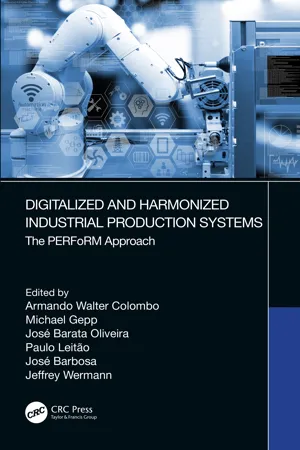
Digitalized and Harmonized Industrial Production Systems
The PERFoRM Approach
- 332 pages
- English
- ePUB (mobile friendly)
- Available on iOS & Android
Digitalized and Harmonized Industrial Production Systems
The PERFoRM Approach
About This Book
On the one side, Industrial competitiveness today means shorter product lifecycles, increased product variety, and shorter times to market and customized tangible products and services. To face these challenges, the manufacturing industry is forced to move from traditional management, control, and automation approaches towards industrial cyber-physical systems.
On the other side, several emergent engineering approaches and related Information?Communication?Control?Technologies, such as Multi?Agent-Systems, Service?Oriented Architecture, Plug?and?Produce Systems, Cloud and Fog Technologies, Big Data and Analytics, among others, have been researched during the last years. The confluence of those results with the latest developments in Industrial Digitalization, Systems?of?Cyber-Physical-Systems Engineering, Internet?of?Things, Internet?of?Services, and Industry 4.0 is opening a new broad spectrum of innovation possibilities.
The PERFoRM (Production-harmonizEd-Reconfiguration of Flexible Robots and Machinery) approach is one of them. It teaches the reader what it means when production machines and systems are digitalized and migrated into Industrial Cyber-Physical Systems and what happens when they are networked and start collaborating with each other and with the human, using the internet.
After a Technology Trend Screening and beyond a comprehensive state-of-the-art analysis about Industrial Digitalization and Industry 4.0-compliant solutions, the book introduces methods, architectures, and technologies applicable in real industrial use cases, explained for a broad audience of researchers, practitioners, and industrialists.
Frequently asked questions
Information
Foreword 1
Chief Technical Officer, Ecosystem Division, Intel Corporation (Retired), USA
President, IEEE Technology and Engineering Management Society (TEMS)
Senior Adcom, IEEE Industrial Electronics Society
Foreword 2
Michigan Technological University
Houghton, MI, USA
Foreword 3
Enabling the Industrial Digital Transformation
SAP
Industrie 4.0 & Digital Supply Chain Innovation
Dietmar Hopp Allee 16
Walldorf, Germany
Preface
Table of contents
- Cover
- Half Title
- Title
- Copyright
- Contents
- Abbreviations
- Foreword 1
- Foreword 2
- Foreword 3
- Preface
- Acknowledgments
- Editors
- Contributors
- Disclaimer
- 1. PERFoRM: Industrial Context and Project Vision
- 2. Technologies and Standards
- 3. PERFoRM System Architecture
- 4. Architectural Elements: PERFoRM Data Model
- 5. Architectural Elements: Technology Adapters
- 6. Architectural Components: Middleware
- 7. PERFoRM Methods and Tools
- 8. Migration Strategy toward Innovative, Digitalized, and Harmonized Production Systems
- 9. Test Beds
- 10. Use Case: Compressors
- 11. Use Case: White Goods
- 12. IFEVS Use Case
- 13. PERFoRM Approach: GKN Use Case
- 14. PERFoRM Approach: Lessons Learned and New Challenges
- Index